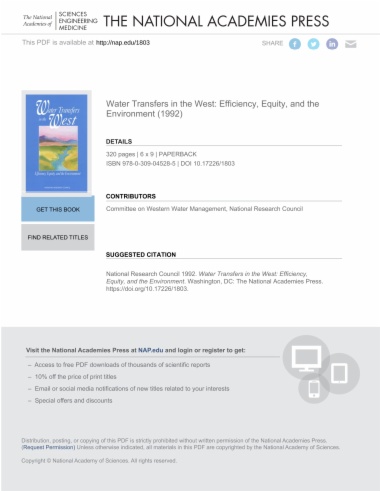The American West faces many challenges, but none is more important than the challenge of managing its water. This book examines the role that water transfers can play in allocating the region's scarce water resources. It focuses on the variety of third parties, including Native Americans, Hispanic communities, rural communities, and the environment, that can sometimes be harmed when water is moved.
The committee presents recommendations to guide states, tribes, and federal agencies toward better regulation. Seven in-depth case studies are presented: Nevada's Carson-Truckee basin, the Colorado Front Range, northern New Mexico, Washington's Yakima River basin, central Arizona, and the Central and Imperial valleys in California.
Water Transfers in the West presents background and current information on factors that have encouraged water transfers, typical types of transfers, and their potential negative effects. The book highlights the benefits that water transfers can bring but notes the need for more third-party representation in the processes used to evaluate planned transfers.
- Cover
- Front Matter
- Summary
- 1 Pressures for Change
- 2 Third Party Impacts and Opportunities
- 3 The Role of Law in the Transfer Process
- 4 Assessing Water Transfers and Their Effects: An Introduction to the Case Studies
- 5 The Truckee-Carson Basins in Nevada: Indian Tribes and Wildlife Concerns Shape a Reallocation Strategy
- 6 Colorado Front Range-Arkansas River Valley: Interconnected Water Sources
- 7 Northern New Mexico: Differing Notions of Water, Property, and Community
- 8 The Yakima Basin in Washington: Will Transfers Occur Without Judicial or Legislative Pressures?
- 9 Central Arizona: The Endless Search for New Supplies to Water the Desert
- 10 California's Central Valley: Fear and Loathing in Potential Water Markets
- 11 California's Imperial Valley: A 'Win-Win' Transfer?
- 12 Conclusions and Recommendations
- Appendix A: Glossary
- Appendix B: Acknowledgements of Case Study Participants
- Appendix C: Biographical Sketches of Committee Members and Staff
- Index

